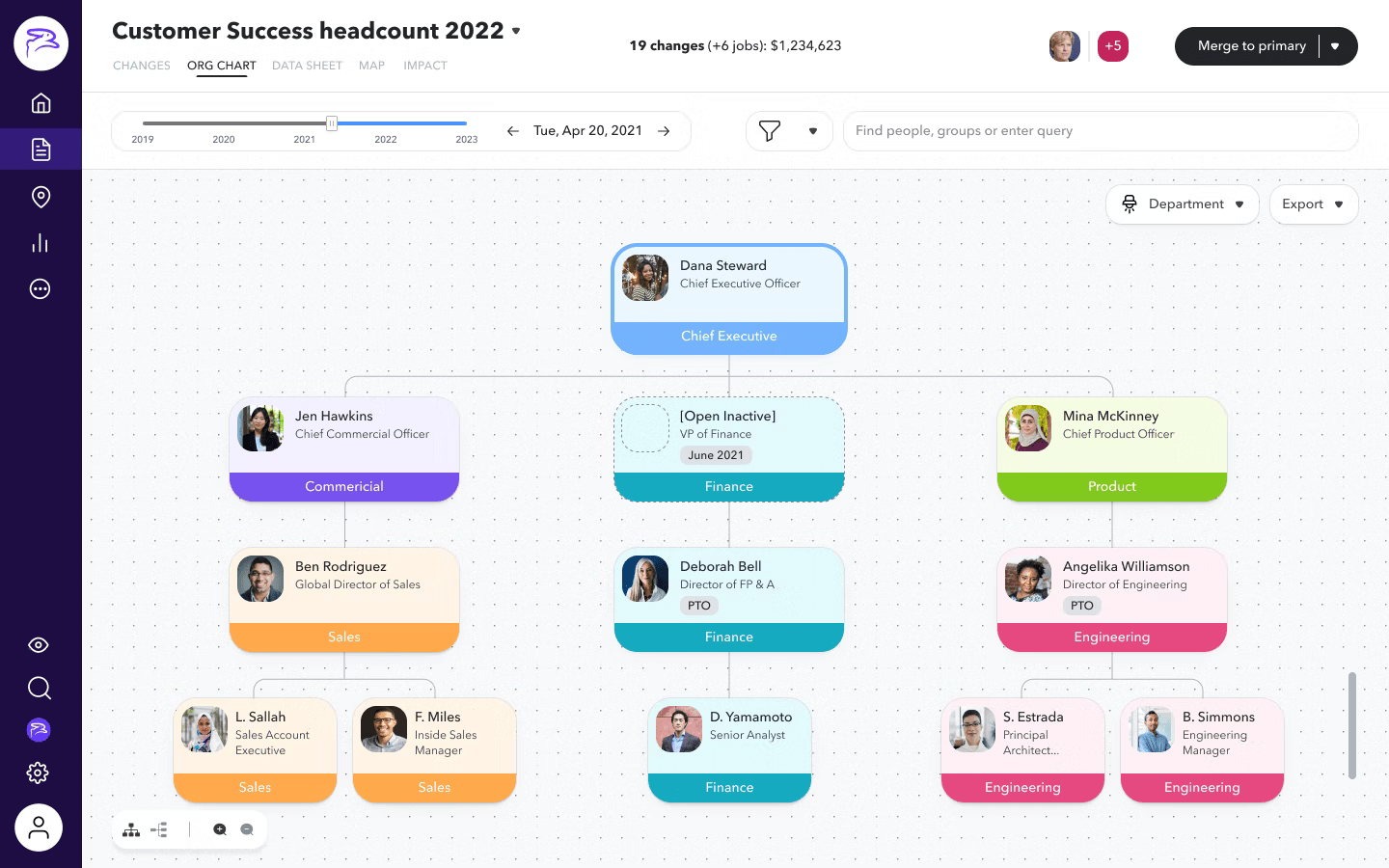Learn how workforce planning can help your organization ensure a stronger workforce.
According to Gartner’s 2021 Hype Cycle for Human Capital Management Technology[1], the use of workforce planning in human resources and talent management is on the rise and expected to reach widespread adoption levels in the next two to five years.
The emergence of this trend is well-timed: In the U.S. alone, over 4.5 million employees left their jobs in March 2022[2]. At the same time, the number of open jobs hit a record high of 11.55 million, meaning open positions exceed available workers by 5.6 million. With these statistics in mind, it’s never been more important for SMBs to leverage workforce planning than it is now.
So if you’re a human resources professional in charge of recruitment at your small- to midsize organization, you’ll want to start thinking about the strategies and technology your company can adopt to ensure a stronger and better equipped workforce. We’ll be going over several important topics in regard to workforce planning:
Ready to hire a recruiting agency for your business needs? Browse our list of companies in the following areas:
1. What is workforce planning?
Workforce planning is an element ofWorkforce planning is important because it allows you to make better decisions about how to effectively use the talent you have, as well as what resources should be allocated to recruiting efforts and when. Given today’s reality of market fluctuations and economic uncertainty, HR leaders need to be prepared to support ongoing and effective workforce planning efforts.
According to Gartner[3], a workforce plan can be strategic and investment-focused, meaning it’s geared toward a holistic vision of your future workforce goals, or tactical and activity-focused, in which it’s more concerned with the steps it takes to reach those goals. The graphic below shows different workforce planning examples and where they fall along this spectrum.

These types of workforce planning focus on different sets of questions, as outlined in the table below:
Workforce optimization: How can we optimize the assignment and distribution of tasks and processes to improve productivity and other business outcomes?
Workforce scheduling optimization: How can we optimize employee schedules to meet compliance and fair scheduling needs while ensuring that we can hit business targets?
Operational workforce planning: How can we plan for the right number and types of resources to hit our projected business targets?
Organization modeling and transformation management: How can we align resources to our new organization structure following significant changes such as restructuring?
Strategic workforce planning: What are the workforce implications of our short- and long-term organizational strategy? Will we have the right skills and resources? If not, how could we get them?
2. How can SMBs leverage workforce planning?
SMBS can leverage workforce planning to:
Increase employee retention. Workforce planning strategies such as career pathing align opportunities for employee career growth with organizational talent priorities. Supporting current employees in their career goals is one way to keep them on board.
Improve recruitment efforts. Hiring the right people saves your business time and money. Having a streamlined application and interview process is one way to do this.
Close the skills gap. Investing in learning and development initiatives to enhance skill sets is what Gartner[4] calls a “save-to-invest strategy,” which allows businesses to invest money they saved on in-person activities during the pandemic in new initiatives.
Benchmark progress. HR benchmarks help you compare your organization’s key HR metrics to those from similar businesses. Benchmarking can also entail comparing your present-day metrics to results from years prior.
3. What are some examples of areas that benefit from workforce planning?
According to Gartner[1], workforce planning benefits those in HR and finance by providing a shared view of the current workforce, as well as the changes that must occur to meet strategic and operating business objectives. It supports both short- and long-term strategic business goals such as post-pandemic renewal, location strategy, and digital business transformation.
The workforce planning process also benefits industries that rely on specialized talent acquisition, such as healthcare, IT, and manufacturing. This is because it’s more critical for these industries to keep their organizations staffed with qualified employees, and to create a plan for contingent staffing in the event of change.
3.1 Workforce planning in healthcare
Nurse and unit managers at hospitals and other healthcare facilities are two particular roles that would benefit significantly from healthcare workforce planning. According to Becky Kahn, Senior Vice President of Strategic Accounts and Managed Services at AMN Healthcare[5], workforce planning in healthcare is currently more akin to “a guesstimate [than a science].”
“If healthcare workforce planning could be more of a science, it would reduce the burden on clinical managers while enhancing efficiency and patient care, as well as improve staff morale.”
Instead, current practices involve “rough estimates, repeating past practices, and even guess work,” which can end up consuming more time because of the constant need to fill gaps.
While workforce planning in healthcare is available, it’s not yet widely used. However, it could benefit healthcare organizations by saving between 4% and 7% of their total labor spend, ensuring adequate staffing, and reducing scheduling issues that can otherwise hurt staff morale.[5]
3.2 Workforce planning in IT
According to Gartner[6], the post-pandemic shift toward remote/hybrid working has further increased the competition for IT talent, making workforce planning a smart move for those in IT.

Talent management framework, such as in the example shown above, can help IT leaders identify and prioritize digital skills and talent needs, devise strategies for these areas to evolve, and develop the workforce in line with changing business priorities.
3.3 Workforce planning in manufacturing
Manufacturing is yet another industry where the competition for talent has increased rapidly. The COVID-19 pandemic resulted in the elimination of around 1.4 million U.S. manufacturing jobs, according to a Deloitte analysis of U.S. Bureau of Labor Statistics data[7]. Approximately 41% of those jobs have yet to return.

Workforce planning can benefit those in manufacturing by:
Providing a clear understanding of organizational needs, including where new employees are needed, and where the current workforce can be upskilled.
Analyzing financial data for an informed stance on which staffing needs to prioritize.
Forming training programs to support workforce development for both new and existing employees.
4. What software systems support workforce planning?
The following software systems support workforce planning by connecting tactical and strategic workforce planning activities.
4.1 Human resources software
Human resource software, also known as a Human Resources Information System (HRIS) or Human Resources Management System (HRMS), helps organizations manage employee
records and information.
4.2 Strategic planning software
Strategic planning software gives companies a centralized place to define business performance objectives, collect data, track progress, analyze trends, and predict outcomes. The software automatically collects key performance metrics from a business’s software ecosystem to assemble a historical record of past performance. Decision-makers can then analyze trends and use predictive modeling to make informed decisions about future resource allocation.
4.3 Succession planning software
Succession planning software helps organizations identify and develop promotable employees for all the key areas in the company. By helping your business promote from within, these platforms can help reduce costs associated with talent acquisition.
4.4 Workforce management software
Workforce management software helps companies plan, track, and manage employee operations such as scheduling and tracking time and attendance. Workforce management solutions help organizations optimize scheduling of current staff, reduce labor costs, and increase employee engagement, all while ensuring compliance with applicable labor laws.
5. What can you use instead of workforce planning in the near term?
If your organization isn’t experiencing exponential growth, you can get by without workforce planning in the near term. Here are some best practices for achieving your ideal headcount and skills distribution without workforce planning:
Create an organizational chart that includes all job functions that your company needs to operate. Org chart software, such as the example below, can help you with this.

Image from org chart software platform ChartHop
Be vigilant for signs of insufficient staffing. Insufficient staffing levels are often indicated by employee burnout, low morale, customer complaints, and more frequent service failures.
Calculate whether your organization can afford to hire more employees. Divide your annual revenue by your employee count, and divide by 12. This is what it costs each month to sustain each employee at your organization.
